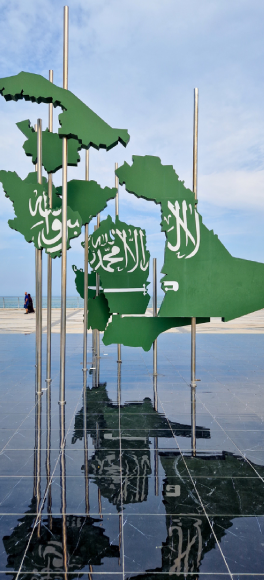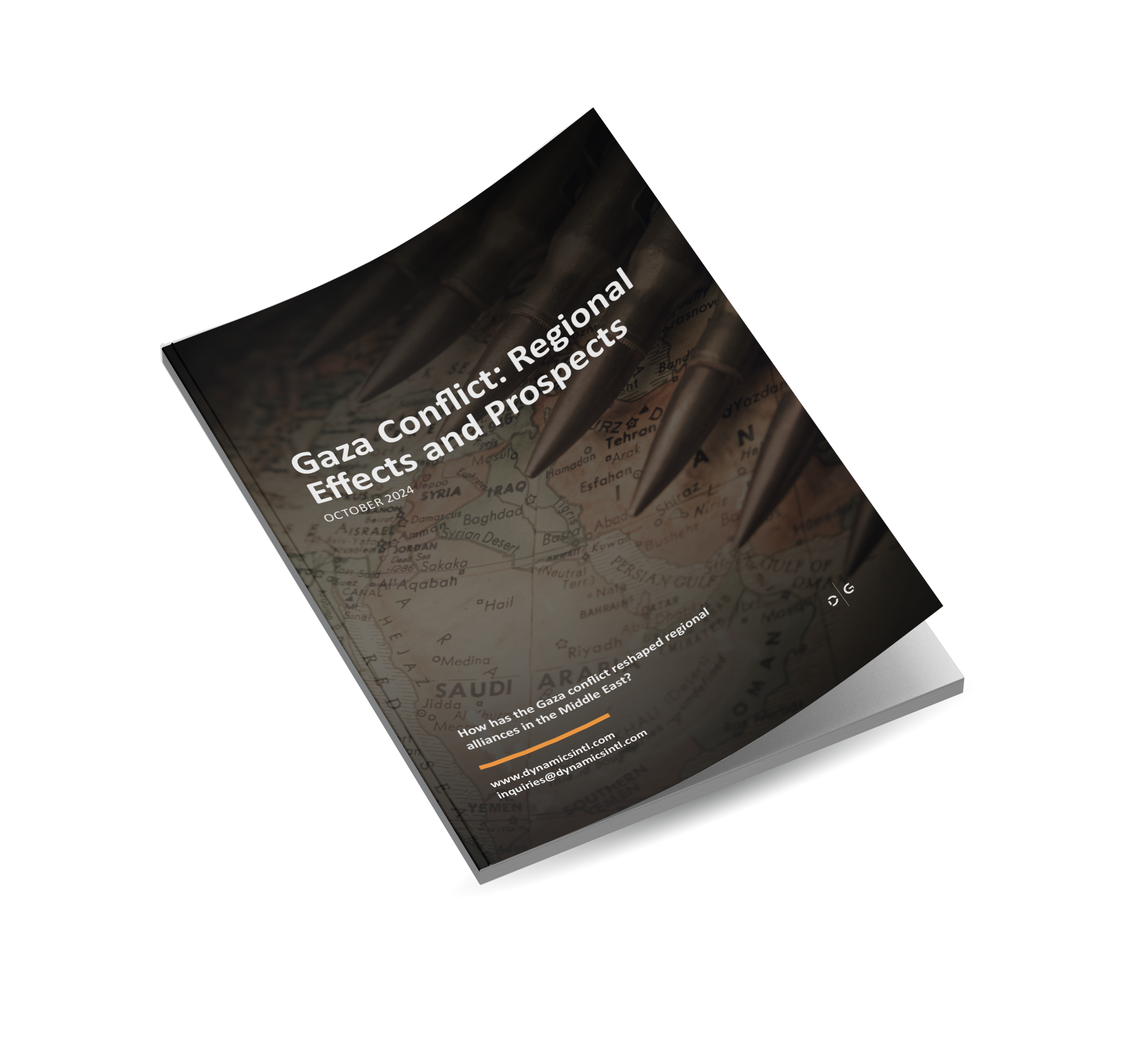Listen to the article – Gaza Conflict: Regional Effects and Prospects
The conflict in Gaza represents one of the most intense confrontations between Israel and Palestine in recent history, further straining the already fragile geopolitical landscape of the Middle East
This deep-rooted conflict, stemming from long-standing territorial and ideological divides, reverberates beyond the region, influencing wider geopolitical concerns. Its geopolitical effect is profound, with far-reaching consequences that exacerbate the power vacuum, deteriorate regional security, and shape Middle Eastern diplomatic discourse and new alliances. Additionally, the conflict has accelerated the pursuit of economic diversification strategies beyond traditional cooperative frameworks in Middle Eastern countries. Understanding the complexity of this conflict is crucial for analyzing its current regional drift, prospects, and implications for business decision-makers operating in the region.
Recommendations for Business Decision Makers
- Prepare for heightened geopolitical volatility and market disruptions
As regional actors attempt to fill the power vacuum, businesses must prepare for heightened political volatility. Sudden policy shifts, regulatory changes, and shifting alliances could disrupt markets, requiring companies to closely monitor developments and engage locally to navigate political instability.
- Strengthen crisis management and create resilient supply chains
The conflict increases risks of regional spillovers, threatening supply chains, operations, and personnel. Companies operating in the region may face logistical delays and higher security costs. Businesses should strengthen crisis management and create flexible, resilient supply chains.
- Reconsider diversification strategies across the region
Middle Eastern countries are moving away from traditional alliances, exploring new partnerships with stakeholders across the region and beyond. Businesses aligned with Western markets or tied to the region’s traditional frameworks may need to reconsider strategies and seek new opportunities as diplomatic and economic priorities shift. Also, businesses dependent on stable energy supplies must reconsider diversifying sources, secure contracts, or explore alternative energy investments to mitigate these risks.
- Expect changes in regulatory and trade policies, as well as market volatility
The conflict poses risks to critical energy routes, likely leading to potential price spikes and supply chain disruptions. As major powers intervene to protect energy interests, businesses should anticipate regulatory scrutiny, trade policy shifts, and remain adaptable to the evolving geopolitics and emerging international competition in the region.
01
Widening Power Vacuum
01
Widening Power Vacuum
The Gaza conflict widened the power vacuum in the region which Middle Eastern states seized as an opportunity to assert their influence and pursue their respective national interests.
The widening power vacuum[1] stems from the blowbacks of the historical policies of Western actors beginning with the turn of the century. These “boomerangs” have gradually led to the diminishing influence and a growing sense of resentment from regional stakeholders who see their presence as detrimental. More recently, the shift in focus towards Eastern Europe and the Ukraine conflict,[2] has further reduced their direct engagement in Middle Eastern affairs.
This has prompted countries in the region to capitalize on the situation, while Western actors have been gradually scaling back their diplomatic, financial, and military interventions, which had already been stretched thin over the years of involvement in regional conflicts.
Download Report
Gaza Conflict: Regional Effects and Prospects
The Gaza conflict deeply affects the Middle Eastern geopolitical landscape, straining regional security, alliances, and economic strategies.
The ongoing war in Ukraine has depleted Western capabilities and emboldened countries in the Middle Eastern region to pursue their own strategic agendas. As a result, states like Qatar, Kuwait, and the UAE[3] have begun limiting strikes on Iran from their territories, signaling a shift towards a more autonomous regional stance. Additionally, some countries have outright demanded an end to US military presence,[4] perceiving it as more of a liability than an asset. In addition, the unconditional support for Israel, emboldened Israeli officials to expand their operations in Lebanon and Syria, increasing the probability of a regionalized conflict. Such trend has further inflamed the region, with political assassinations becoming frequent, worsening the overall regional instability. However, it is important to note that despite the perception of “pulling out” of Western actors from the Middle East and the current focus on Ukraine, they have not fully withdrawn from the region.
They continue to maintain a strategic military and economic presence,[5] limiting the extent to which regional powers can maneuver without facing pushback, also retaining the security and political connections in the region. Hence, the long-lasting conflicts in the region created opportunities for Middle Eastern states to expand their influence pursuing their national interests, while traditional powers focused their attention away from the region.
02
Deteriorating Regional Security
02
Deteriorating Regional Security
The “spill-over” of the Gaza conflict into the neighboring region is prompting Middle Eastern countries to get involved in the regional security trends and take proactive measures which will likely escalate the conflict, further deteriorating regional security.
The “spilled over” war in Lebanon heightens the likelihood of escalation of the conflict in the region, and the recent air strikes in Syria raises the concerns about the deteriorating security. The unpredictability of the regional security situation indicates that several Middle Eastern countries may be drawn into military engagement with Israel, particularly under the justification of protecting the Palestinian population as well as those in Lebanon,[6] with the aim to prevent major escalation. In Jordan, officials have raised concerns that Israel’s ongoing military operations pose an existential threat to the kingdom’s stability. Additionally, Yemen’s already fragile situation faces the threat of further escalation, especially with the Houthis increasing their activities, strategically maneuvering to tighten the grip over key shipping lanes, complicating military strategies across the Middle East and the regional diplomatic discourse. In fact, the Houthis targeted more than eighty merchant ships in the Red Sea and Gulf of Oman since October 2023.
Amid this escalator cycle, regional actors have sought to mediate and manage the conflicts. Iran has amplified regional tensions, calling for a ceasefire in Gaza alongside other Arab states, while continuing to support proxy actors, and also deciding to launch a missile barrage towards Israel in October 2024. Egypt has taken a leading role in trying to broker a ceasefire in Gaza while engaging in diplomatic dialogues with Israel.[7] Despite US pressure, Egypt notably refused to close its airspace, indicating a shift toward more independent regional policies. Turkey has also joined mediation efforts, demonstrating broader regional attempts to resolve the conflict through diplomatic means. However, diplomacy and calls for peace are just part of the equation, as China, Iran, and Russia recently conducted joint naval exercises in the Gulf of Oman, signaling their intent to assert military presence and influence in the region.
While certain countries in the region are stepping forward with mediation efforts, and calls for immediate ceasefire, the overall security situation remains precarious due to the ongoing Israeli actions, coupled with the involvement of the Iran-backed axis, which continue to heighten the risk of a wider conflict or even a nuclear confrontation.[8] Consequently, despite regional efforts, the instability is likely to persist with long-term resolution dependent on managing both historical rivalries among Middle Eastern states and the involvement of external powers will likely hinder the effectiveness of independent security dialogues.
03
Shifting Alliances
03
Shifting Alliances
Recent diplomatic developments across the Middle East suggest a coordinated political shift, as various states seek to realign their regional relations by forming alliances outside the established traditional frameworks, prioritizing their national objectives as a response to the escalating conflict.
In the lead-up to the Ukraine conflict, numerous Arab nations have already begun to diversify their global relationships, motivated by apprehensions regarding the United States’ shift towards Asia. The normalization of relations between the UAE, Bahrain, and Israel under the Abraham Accords in 2020 marked the beginning of a trend where Gulf states assert greater engagement in diplomacy, aiming to bypass longstanding conflicts. This was followed by Turkey’s efforts to rebuild ties with Egypt and the UAE, signaling a broader regional recalibration. Saudi Arabia’s reconciliation with Iran in 2023,[9] facilitated by China, further highlights this shift, indicating a growing trend of regional actors aiming to resolve tensions through diplomatic engagement, at times involving external mediators.
Moreover, Syria’s reintegration into Arab diplomacy, with its readmission to the Arab League in May 2023 and the restoration of ties with Arab states, exemplifies the wider regional effort to stabilize and normalize political relations. However, while these developments indicate a regional desire for independent diplomacy, external actors continue to assert their influence in the Middle East. For instance, the 2022 Jeddah Security and Development Summit, attended by the US President, reaffirmed Washington’s commitment to regional security and partnerships, signaling Western interests in countering Chinese and Russian influence. Moreover, the ongoing strategic relationship between Saudi Arabia and the US, as highlighted in their renewed 2024 dialogue,[10] suggests that while regional actors may seek autonomy and engage in direct diplomatic endeavors. Western powers, nevertheless, remain deeply embedded in Middle Eastern geopolitics, particularly through military alliances, economic ties, and energy interests.

In addition, Saudi Arabia and the UAE have strengthened their ties with Russia and China[11] across various sectors, including energy, trade, and defense. While enhancing these connections, they simultaneously advocate for a continued US military presence, reflecting a dual strategy that balances the maintenance of long-standing alliances with the exploration of new partnerships. Furthermore, the quest for independent economic and political avenues becomes increasingly apparent through several initiatives. For example, Iran’s partnership with China via the Belt and Road Initiative signals a clear move towards alliances that challenge Western hegemony, while also positioning itself within the Shanghai Cooperation Organization.[12] Noteworthy mention is the deepening Iran-Russia cooperation which will likely be “upgraded” to strategic cooperation encompassing political, economic and military aspects on the BRICS summit in October 2024.
Also, Saudi Arabia, UAE, Iran and Egypt are the Middle Eastern countries that joined BRICS in 2024. Additionally, Turkey’s application to join BRICS and the initial approval of the Pakistani’s request to join the forum[13] are being considered, reflecting an effort to strengthen their respective regional standing beyond the traditional Western alliances. Moreover, one year after the October 2023 attacks, the Iranian parliament is drafting a bill to create a military alliance with the countries of the so-called Resistance Axis to repel any future attacks by Israel.[14] Ultimately, these developments highlight the collective desire among Middle Eastern states to navigate an increasingly multipolar world with greater autonomy, even while contending with domestic political limitations and economic dependencies.
However, despite these efforts towards diversification of alliances, internal political constraints and economic reliance challenge the complete strategic autonomy of many Middle Eastern nations. For instance, the complex relationship between the US and Saudi Arabia remains strained due to disagreements over human rights and oil production, yet Saudi Arabia’s continued participation in the OPEC+ oil policy reflects its reliance on traditional economic frameworks that are difficult to abandon entirely. Moreover, the India-Middle East-Europe Economic Corridor (IMEC),[15] which is an US-led initiative designed to enhance connectivity between India, Europe, and the Gulf, demonstrates that traditional Western frameworks still play a crucial role in the regional dynamics.
Thus, the diplomatic developments in the region indicate that countries are politically shifting in pursuit of reviving regional diplomacy according to their respective national objectives. While the desire for new alliances is evident, the interplay of internal dynamics and economic pressures suggests that achieving complete strategic independence may prove challenging for these countries.
04
Economic Diversification Strategies
04
Economic Diversification Strategies
Triggered by the protracted Gaza conflict and decades of economic stagnation, countries in the Middle East are pursuing economic diversification strategies aiming to reduce their dependency on traditional cooperative frameworks.
The Middle Eastern conflicts have effectively brought economic activity in the region to a standstill. In response to this stagnation, countries in the Middle East are increasingly pursuing economic diversification strategies to reduce their dependency on traditional revenue sources and to enhance their ability to enact autonomous policies. In fact, these strategies are evident not only with China, yet across Asia.[16] A notable example of this shift is Saudi Arabia’s ambitious NEOM project, which is part of its broader Vision 2030 initiative, aimed at fostering a sustainable, self-sufficient, technology-driven economy. Moreover, in November 2023 Saudi Arabia signed a currency exchange agreement with China, signaling a shift towards using local currencies in international trade. Likewise, India and UAE have formalized their bilateral trade relationship aimed at settling transactions in their respective local currencies. Similarly, UAE is positioning itself as a global logistics and financial hub. UAE’s partnership with China is another important aspect of this diversification strategy.
With sizable investments focused on infrastructure, sustainability, and energy security, the bilateral trade between China and UAE is projected to reach USD 300 billion by 2030.[17] This collaboration not only strengthens UAE’s position as a regional hub for Chinese enterprises but also aligns with its broader goals of economic diversification and technological advancement. Oman’s relationship with China exemplifies another facet of Middle Eastern nations striving for economic diversification. The two countries have enhanced their trade relations reaching USD 40.45 billion.[18] Their strategic partnership, established in 2018, has led to successful projects in infrastructure, technology, and education, emphasizing the importance of mutual trust and cooperation in achieving shared economic objectives. Equally, Iran’s strategic partnership with China, solidified through a 25-year agreement aimed at enhancing economic and security ties, highlights a different approach to diversification. As US administration has expressed concerns over this emerging alliance, it is evident that Iran is leveraging its oil exports to deepen its collaboration with China, which has led to a significant increase in oil trade and various cooperation agreements across multiple sectors.
However, the complex geopolitics of the Middle East characterized by resurging regional conflicts, complicates these economic diversification efforts. UAE’s President visit to the White House, which solidified UAE’s status as a “major defense partner,” reflects the shifting dynamics as UAE engages with various stakeholders, including Russia, Afghanistan and Iran.[19] In light of these developments, it is highly probable that Saudi Arabia and the Gulf Cooperation Council will gradually redirect their funds from US defense procurements towards emerging economic priorities as ongoing peace agreements are implemented.[20]
Therefore, reacting to the decades-long economic stagnation and resurging conflicts, Middle Eastern countries are pursuing diversification strategies to reduce the dependency from traditional revenue sources and partners aiming to improve their ability to independently perform in the international arena and enact policies that prioritize their respective national objectives.
05
Energy Security Risks
05
Energy Security Risks
The escalation of the Gaza conflict creates global energy security risks that will likely disrupt oil and gas supplies, increase price fluctuations, impacting broader international markets. This will likely be the trigger for involvement of major powers, further inflaming the conflict.
As far as energy security issues are concerned, the Middle East region is fundamentally important, as it holds nearly 48 percent of global oil reserves as well as forty percent of the world’s gas resources. Also, the interconnected nature of energy markets means that disruptions in one region can have a cascading effect on another, which further complicates the strategic calculus for involved actors. The ongoing war in Ukraine has initially disrupted energy supplies to Europe, highlighting the importance of the Middle Eastern energy market as a dominant player and its influence cannot be entirely offset in the short term, making energy security highly contingent on regional stability.
In this context, Saudi Arabia, UAE, and Iran, have key roles in the global energy market and have substantial influence over production levels through their membership in OPEC and OPEC+. Furthermore, Egypt has emerged as a key player in exporting natural gas, processing Israeli gas into liquefied natural gas and re-exporting it to Europe as well as Asia.[21] Additionally, the war in Ukraine has revived interest in projects like the East Med pipeline, which would link Israeli and Cypriot gas fields to European markets, although there are doubts about its feasibility due to technical, economic, and political challenges. For instance, Turkey’s ambitions in the Eastern Mediterranean,[22] the energy-related geopolitical tensions challenging the energy exploration activities of Greece, Cyprus, and Israel, arguing that the Turkish-controlled northern Cyprus and Turkey itself have rights to the region’s resources as well.
Download Report
Gaza Conflict: Regional Effects and Prospects
The Gaza conflict deeply affects the Middle Eastern geopolitical landscape, straining regional security, alliances, and economic strategies.
Furthermore, escalating tensions may affect these countries’ ability to meet production targets, either through deliberate policy shifts or due to direct impacts on infrastructure. Currently, the Arab-Israeli conflict is not impacting major commodity producers directly, yet the spill-over effect is already exerting indirect influence on the flow and global prices of these resources.[23] Given these circumstances, the emerging alliance between the Houthis in Yemen and Somalia’s al-Shabaab reflects a concerning development in the energy security dynamics in the maritime domain. Such aligning with al-Shabaab, indicates that the Houthis are expanding their reach and influence beyond Yemen, seeking to disrupt global shipping and exert pressure on international trade. For regional and global powers, this alignment presents a challenge, as the US, European countries, and Gulf states rely heavily on the security of these shipping routes. Should the Houthis and al-Shabaab succeed in coordinating attacks, the result will likely be heightened military responses, escalation of tensions and energy market volatility. On one hand, the region’s energy resources offer potential for increased cooperation, especially through forums like the East Mediterranean Gas Forum and projects such as the Arab Gas Pipeline. On the other hand, unresolved disputes and raging conflicts, threaten to destabilize the region which will likely lead to market instability, undermining efforts by major powers to stabilize energy markets, particularly as the global economy grapples with inflation and post-pandemic recovery challenges.
Hence, the escalation of conflict introduces severe risks to global energy security, with potential disruptions in oil and gas supplies, increased price volatility, and broader impacts on international markets, which will likely be the trigger for great powers’ intervention.
06
Prospects
06
Prospects
The prospects for the region amid the escalating Gaza conflict suggest a deepening complexity, with far-reaching implications for regional stability, alliances, economic strategies and energy security. As Middle Eastern countries respond to the widening power vacuum and the increasing regional instability, the region is likely to see a period of major geopolitical and economic recalibration and increasingly volatile energy market.
First, the widening power vacuum in the region is prompting key regional actors to assert their influence in alignment with their national interests and will likely contend for greater control or influence over the conflict’s trajectory, as each sees the instability as an opportunity to enhance their respective regional standing. Iran will likely continue to support regional proxies as means of maintaining its opposition to Israel and expanding its influence in the region, while Turkey seeks to position itself as a champion of the Palestinian cause to boost its role as a leading regional power.
Egypt, concerned with securing its borders and controlling the flow of refugees, will likely aim to mediate and manage the conflict but is also facing internal public pressure as a result. This competition for influence will likely aggravate tensions in the region, contributing to further regional destabilization.
Second, the conflict’s spill over into Lebanon and recently Syria, as well as the periodical “missile exchange” between Israel and Iran has rung the alarm bell of countries in the region, increasing their posturing as these sets of events are undermining regional security even further. Direct military engagement by Middle Eastern countries and/or the indirect participation of key major and regional powers in shaping the political discourse, risks spreading the conflict across the whole Middle Eastern region. As the conflict continues on the escalatory path, sectarian divisions could be exacerbated, fueling broader rivalries, further fueling the broader destabilization that impacts the entire region.
Third, the Gaza conflict revealed that the broader geopolitical realignment is already underway in the region. The normalization of relations of Middle Eastern countries with Israel will likely be reverted due to the humanitarian toll of the conflict, coupled with the intensification of local pressures to support the Palestinian cause. Public opinion in Middle Eastern countries will likely push these governments to reassess their diplomatic ties with Israel, although security and economic interests may temper any dramatic shifts. At the same time, these states increasingly seek deeper ties with non-traditional allies such as China and Russia, whose more neutral stance on the conflict offers them alternatives to the West’s pro-Israeli policies. Such shifting of alliances marks a departure from the historical US-centric security architecture in the region and will likely reshape the geopolitical landscape over the coming years.
Fourth, prolonged economic stagnation and the continuity of the Gaza conflict are driving Middle Eastern countries to adopt diversification strategies aimed at reducing dependency on Western-based cooperative frameworks. The conflict, coupled with broader regional instability is compelling countries in the region to fast-track their diversification plans designed to reduce reliance on traditional revenue sources and foster economic cooperation with non-traditional partners. Such discourse further weakens the dominance of traditional Western economic frameworks in the region and suggests that Middle Eastern countries will likely increasingly pursue independent economic policies aimed at fostering resilience in the face of both geopolitical and economic volatility.
Finally, the escalation of the Gaza conflict introduces the energy security risks, which are likely to draw in major powers. The Middle East remains a critical hub for global energy supplies, and any further destabilization, where key shipping lanes are being threatened, could have serious implications for global energy markets. In addition, the risk of supply chain disruptions will likely accelerate interventions from major powers which have vested interests in maintaining energy security.
Therefore, the escalation of the Gaza conflict suggest that the region will likely be facing rising insecurity, deteriorating stability and a period of major geopolitical and economic recalibration.
07
Summary
07
Summary
The conflict in Gaza accelerated the reassessment of traditional alliances in the region, with many Middle Eastern countries recalibrating their strategic approach away from Western mediation. The widening power vacuum and the deteriorating regional security have created an environment in which emerging alliances, between Gulf states and Asian powers are reshaping Middle Eastern diplomacy.
These countries are increasingly pursuing independent paths in response to shifting global realignment, focusing on economic diversification strategies leveraging energy resources to reduce reliance on Western markets and influence. However, despite these shifts, Western actors remain deeply entrenched in the region, driven by strategic interests in energy security, counterterrorism, and military presence. This ongoing involvement often exacerbates tensions and fuels the instability that undermines efforts to create stable regional security architectures and improve economic sustainability. The competition between Western powers and rising global players for influence complicates alliances and disrupts the economic trajectories of Middle Eastern countries, particularly as they manage the challenges of maintaining their overall security and economic sustainability amid ongoing conflicts.
In this complex set of circumstances, Middle Eastern diplomacy will likely continue to evolve, redrawing the lines with balancing old and new alliances as well as economic strategies alongside the persistent presence and influence of major powers.

ARTICLE | 27 PAGES




